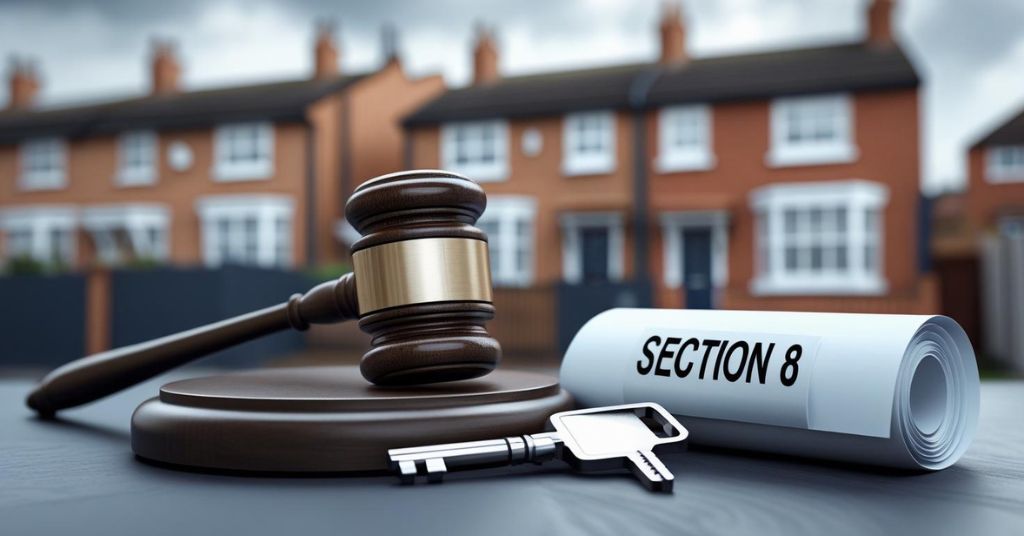Evicting a tenant is one of the most difficult and stressful parts of being a landlord. Whether it’s due to rent arrears, damage, or a breach of agreement, sometimes it becomes necessary to take legal action. One of the main legal routes is the Section 8 eviction process.
If you’re not familiar with it—or you just want a smoother, less risky way to handle it—this guide is for you.
Instant Rental Price Estimator
Discover your property’s true rental value in seconds with our free, UK-wide price comparison tool.
What is a Section 8 Notice?
Landlords can use a Section 8 notice to reclaim their property when tenants breach the tenancy agreement. The most common reason is serious rent arrears—usually two full months’ worth.
You can’t simply tell a tenant to leave. The court requires you to follow a legal process—skipping steps or filing incorrect paperwork may lead the court to dismiss your claim. That’s why it’s so important to approach it properly from the start.
Upcoming Changes Under the Renters’ Rights Bill
The Renters’ Rights Bill, expected to come into force between October 2025 and January 2026, will significantly reshape the eviction landscape:
-
Section 21 evictions will be abolished – You’ll no longer be able to evict tenants without a specific reason. All evictions must go through Section 8.
-
Section 8 grounds will be expanded – This includes new grounds for selling the property or landlords moving in themselves.
-
Rent arrears thresholds will increase – Mandatory eviction for rent arrears will apply once the tenant is three months behind, not two.
-
Notice periods may be extended – For certain grounds like rent arrears, the notice period may increase from 14 days to 28.
-
New landlord requirements – A landlord ombudsman and national database will be introduced to improve transparency and resolve disputes more easily.
In short: Section 8 is becoming even more central to the eviction process. If you’re not already familiar with it, now is the time to get prepared.
What Does the Section 8 Eviction Process Look Like?
Here’s a quick breakdown of what usually happens:
1. Arrears Hit Two Full Months
This is the trigger point. At this stage, you can serve a Section 8 notice.
2. Notice Served to the Tenant
The tenant is formally told they must leave—usually within 14 days (soon to be 28 under proposed changes).
3. Legal Review and Solicitor Involvement
If the tenant doesn’t vacate, the case moves forward. A solicitor prepares for a court hearing.
4. Possession Hearing
A judge reviews the case and, if successful, issues a possession order. The tenant is given a deadline to leave—normally 14 days.
5. Bailiff Enforcement (If Needed)
If the tenant stays past the possession date, court-appointed bailiffs can be requested to remove them. This can take another 4–8 weeks depending on the local court.
What Can Go Wrong in a Section 8 Eviction?
A lot, if you’re not careful.
-
Missing or incorrectly served documents
-
Outdated tenancy agreements
-
Incorrect notice dates
-
Delays in court due to admin errors
Even minor errors may force you to restart the process, delaying eviction by weeks or months.
How We Support You with Section 8 Evictions
At Lettingaproperty.com, we help landlords take the stress out of evictions. If you’re on a plan that includes LetsProtect™, you get:
-
Legal cover for solicitor, court, and bailiff costs
-
Direct support from our in-house claims manager
We make sure:
✅ Your documents are in order
✅ The correct notice is served
✅ The legal process is followed
✅ You stay informed every step of the way
In many cases, we’ve recovered possession faster and with far less hassle than landlords trying to go it alone.
Thinking About Handling a Section 8 Eviction Yourself?
You can—but it’s risky. Even experienced landlords struggle with the admin and court process. That’s why more and more are choosing to work with a professional partner who handles the legal side.
Ready to Take the Stress Out of Letting?
If you want expert support, protection against costly legal fees, and peace of mind when things go wrong, we’re here to help.
Or speak to our team to find out how we handle Section 8 claims from start to finish.
FAQs: Section 8 Evictions for Landlords
1. What’s the difference between a Section 8 and Section 21 eviction?
Landlords initiate Section 8 evictions when tenants breach the agreement (e.g., rent arrears, property damage). A Section 21 eviction is a “no-fault” eviction, but it’s being abolished under the Renters’ Rights Bill (expected late 2025).
2. How much rent arrears are needed for a Section 8 eviction?
Currently, two months’ rent arrears trigger mandatory grounds for eviction. Under the new bill, this will increase to three months.
3. How long does a Section 8 eviction take?
Typically 2–6 months, depending on court delays and whether the tenant contests the claim. If bailiffs are needed, add 4–8 weeks.
4. Can I evict a tenant for antisocial behaviour under Section 8?
Yes, if it’s severe enough to breach the tenancy agreement. You’ll need evidence (e.g., police reports, neighbour complaints).
5. What if I make a mistake in the Section 8 notice?
Errors (wrong dates, improper service) can invalidate the notice, forcing you to restart the process. Legal support minimises risks.
6. Will the Renters’ Rights Bill make evictions harder?
Yes—longer notice periods, stricter grounds, and no Section 21 mean landlords must rely on fault-based Section 8 evictions. Preparing now is crucial.
Resources:



